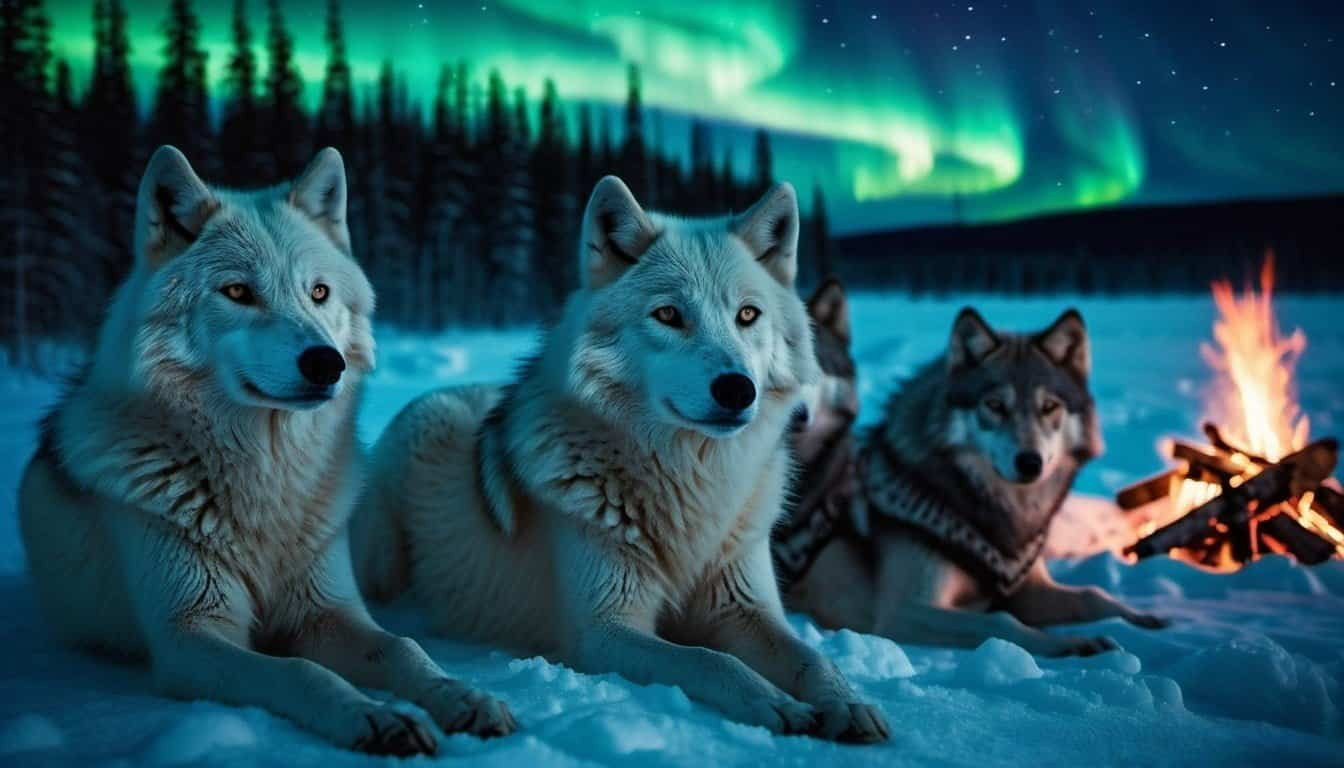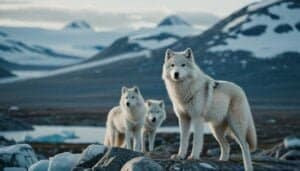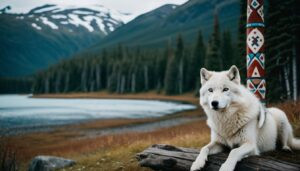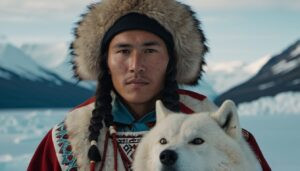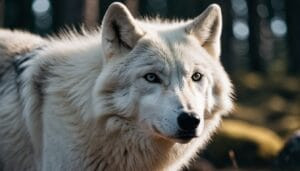Introduction
The Arctic wolf, a resilient and majestic creature, holds a special place in the mythology of indigenous Arctic cultures. These myths and legends not only explain the origins of these wolves but also highlight their roles and symbolism within these communities
This article explores the main myths involving Arctic wolves from Inuit, Saami, and Chukchi cultures, their symbolic meanings, and the influence of these myths on indigenous practices. Dive into the fascinating world of Arctic wolf mythology and discover the rich cultural heritage that surrounds these remarkable animals
Main Myths and Origin Stories of Arctic Wolves
Exploring the main myths and origin stories of Arctic wolves provides a unique insight into the cultural fabric of indigenous Arctic communities
These stories are not just tales of creation but also reflections of the relationship between humans and nature in these harsh environments
Myths from Inuit Culture
The Inuit people, who inhabit regions across the Arctic, including Greenland, Canada, and Alaska, have a rich tradition of storytelling
Among these stories, the Arctic wolf often plays a significant role. One prominent myth involves the creation of the Arctic wolf by the deity Torngarsuk, a powerful spirit in Inuit mythology. According to the legend, Torngarsuk created the wolves to help guide and protect the Inuit people during their hunts and to maintain balance within the ecosystem
In another Inuit legend, the Arctic wolves are considered the spirits of ancestors who continue to watch over their descendants
These ancestral wolves are believed to possess the wisdom and knowledge of the past, guiding the living through dreams and visions. The connection between the wolves and the spirit world underscores the deep respect and reverence the Inuit have for these animals
Myths from Saami Culture
The Saami people, indigenous to the northern parts of Norway, Sweden, Finland, and Russia, also have rich mythological traditions involving Arctic wolves
In Saami mythology, the Arctic wolf is often seen as a sacred animal, imbued with the spirits of the land. One Saami legend tells of a great wolf named Gálláháj, who was created by the god of the underworld to roam the earth and protect the natural order
According to this myth, Gálláháj taught the Saami people how to live in harmony with nature, showing them the ways of the land and the animals. This legend highlights the role of the Arctic wolf as a teacher and guide, emphasizing the Saami belief in living in balance with their environment
The wolf’s presence in their stories reflects its importance in their spiritual and everyday lives
Myths from Chukchi Culture
The Chukchi, indigenous to the Chukotka Peninsula in Russia, have their own unique tales about Arctic wolves
In Chukchi mythology, the Arctic wolf is often depicted as a shape-shifter, capable of transforming into a human. One popular story tells of a Chukchi hunter who encounters a beautiful woman in the wilderness, only to discover that she is actually a wolf in human form
This myth underscores the Chukchi belief in the interconnectedness of all living beings and the fluid boundaries between the human and animal worlds. The shape-shifting wolf symbolizes the adaptability and resilience required to survive in the harsh Arctic environment. It also reflects the deep respect the Chukchi have for the wolf’s intelligence and cunning
These myths from Inuit, Saami, and Chukchi cultures provide a fascinating glimpse into the origin stories and cultural significance of Arctic wolves
Each story reflects the unique relationship these indigenous peoples have with the natural world and highlights the important role of the Arctic wolf in their traditions and beliefs
Roles and Symbolism of Arctic Wolves in Indigenous Cultures
Arctic wolves hold profound symbolic meanings in the myths and legends of indigenous Arctic cultures. These animals are often depicted as more than just wildlife; they embody spiritual, protective, and instructive roles that reflect the deep connections between these communities and their environment
Spiritual and Protective Roles
In many indigenous Arctic cultures, Arctic wolves are considered spiritual guardians. Among the Inuit, for instance, wolves are often seen as protectors of the tribe, ensuring the safety and success of hunters
In Inuit mythology, these wolves are believed to possess spiritual powers that can influence the natural world. The presence of wolves is thought to bring balance and harmony, safeguarding the community from harm
Similarly, in Saami culture, the Arctic wolf is revered as a spiritual being with protective qualities
Saami shamans, known as noaidi, often invoke the spirit of the wolf in their rituals to seek protection and guidance. The wolf’s keen senses and hunting prowess symbolize the noaidi’s ability to navigate both the physical and spiritual realms, offering protection against evil spirits and misfortune
Arctic Wolves as Teachers and Guides
Arctic wolves are also seen as teachers and guides in indigenous Arctic mythology. They are often depicted as wise and knowledgeable beings that impart important lessons to humans
In Saami legends, the great wolf Gálláháj is said to have taught the Saami people how to coexist with nature. This guidance includes understanding the migratory patterns of reindeer, the primary source of sustenance for the Saami, and learning the secrets of the land
In Chukchi stories, the shape-shifting wolf often guides lost hunters back to their villages, symbolizing the wolf’s role as a protector and teacher. These stories emphasize the wolf’s intelligence and its crucial role in helping humans survive in the Arctic’s harsh conditions
The lessons imparted by the wolves in these myths often revolve around respect for nature, the importance of community, and the interconnectedness of all life
Symbolic Meanings in Myths
The symbolic meanings attributed to Arctic wolves in indigenous myths are rich and varied
For the Inuit, wolves symbolize endurance and resilience, qualities necessary for survival in the Arctic. The wolf’s ability to traverse great distances in search of food is seen as a metaphor for the Inuit’s own perseverance in their harsh environment
In Saami culture, wolves are often symbols of strength and courage. The wolf’s role as a hunter and protector mirrors the qualities admired in Saami society
Additionally, the wolf’s presence in Saami mythology as a spiritual guide reflects the community’s belief in the importance of wisdom and knowledge passed down through generations
Chukchi myths highlight the wolf’s adaptability and cunning. The shape-shifting nature of the wolf in these stories symbolizes the ability to navigate and survive in a constantly changing world. This adaptability is a valued trait in Chukchi culture, where survival often depends on one’s ability to respond to the unpredictable Arctic environment
These roles and symbols not only enrich the cultural narratives of indigenous Arctic peoples but also underscore the deep respect and reverence they hold for Arctic wolves. The spiritual, protective, and instructive aspects of these animals in mythology reveal the integral part they play in the cultural and spiritual lives of these communities
Influence of Arctic Wolf Myths on Indigenous Practices
The myths and stories of Arctic wolves profoundly influence the cultural traditions, hunting practices, and storytelling of indigenous Arctic communities. These practices are deeply intertwined with the reverence for Arctic wolves and reflect the values and beliefs embedded in the myths
Cultural Traditions and Rituals
Cultural traditions and rituals among indigenous Arctic peoples often incorporate the reverence for Arctic wolves
For instance, the Inuit hold various ceremonies that honor the spirits of the wolves. These ceremonies may involve dances, songs, and offerings to appease the wolf spirits and seek their protection. During these rituals, the Inuit express their gratitude for the guidance and wisdom that the wolves are believed to provide
In Saami culture, the wolf is celebrated in various festivals and rituals. One such ritual is the “wolf ceremony,” where the Saami people perform dances and chants to honor the wolf spirits
These ceremonies are usually held during significant times of the year, such as the changing of seasons, to seek the wolf’s protection and blessings for the community. The rituals reflect the Saami’s deep respect for the wolf’s role as a guardian and spiritual guide
Hunting Practices and Taboos
Hunting practices among indigenous Arctic communities are heavily influenced by wolf myths and the respect for these animals
The Inuit, for example, have specific taboos and rules related to hunting that are derived from wolf behavior. Hunters are taught to observe the patience and persistence of wolves, emulating these traits during their own hunts. Additionally, there are taboos against killing wolves unnecessarily, as they are seen as vital to maintaining the balance of the ecosystem
The Saami also have hunting practices influenced by wolf mythology. The Saami believe that hunting should be conducted with respect and reverence for the animals
They often perform rituals before and after the hunt to honor the spirit of the wolf and seek its guidance. These practices ensure that the hunt is carried out in a sustainable and respectful manner, reflecting the Saami’s belief in living harmoniously with nature
Storytelling and Preservation of Myths
Storytelling is a crucial aspect of preserving wolf myths in indigenous Arctic cultures. These stories are passed down orally from generation to generation, ensuring that the cultural heritage and wisdom embedded in the myths are not lost
For the Inuit, storytelling sessions often involve elders recounting tales of the Arctic wolves and their origins. These sessions serve not only as entertainment but also as educational moments that impart important cultural values and knowledge
In Saami culture, storytelling is also a vital means of preserving wolf myths. The stories are often shared during community gatherings and festivals, where the younger generation learns about the significance of the Arctic wolf in their culture
These narratives are told with great respect and reverence, emphasizing the moral and spiritual lessons that the wolves represent
The Chukchi people similarly preserve their wolf myths through storytelling. Stories of shape-shifting wolves and their interactions with humans are recounted to teach the younger generation about the interconnectedness of all living beings and the importance of adaptability and resilience
The influence of Arctic wolf myths on these practices highlights the integral role that these animals play in the cultural and spiritual lives of indigenous Arctic communities. The reverence for wolves is evident in their traditions, hunting practices, and storytelling, all of which reflect the deep respect and connection these peoples have with the natural world
Conclusion
Arctic wolves hold a significant place in the mythology and cultural practices of indigenous Arctic peoples
Through exploring the main myths from Inuit, Saami, and Chukchi cultures, we uncover the rich tapestry of stories that explain the origin and symbolic meanings of these majestic animals. These myths highlight the spiritual, protective, and instructive roles that Arctic wolves play in the lives of these communities
In Inuit mythology, Arctic wolves are often seen as guides and protectors, deeply connected to the spirit world. Saami legends emphasize the wolf’s role as a sacred teacher, imparting crucial knowledge for living in harmony with nature
Chukchi stories of shape-shifting wolves underscore the adaptability and interconnectedness of all living beings in the Arctic environment
The influence of these myths extends beyond storytelling, shaping cultural traditions, hunting practices, and rituals. Indigenous Arctic communities incorporate the reverence for Arctic wolves into their ceremonies, ensuring the continued respect and protection of these animals
Hunting practices are conducted with the wisdom and patience observed in wolves, reflecting the deep ecological balance respected by these cultures
Ultimately, the myths and practices surrounding Arctic wolves in indigenous Arctic cultures demonstrate a profound connection to nature and a deep respect for the wisdom and guidance these animals provide
These stories and traditions continue to be passed down through generations, preserving the cultural heritage and ensuring that the legacy of the Arctic wolf remains an integral part of these communities’ identities
